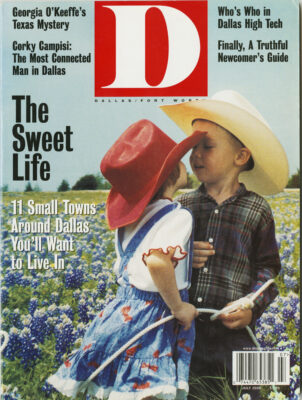The Pecan tree (Carya illinoensis) at 4200 Armstrong Pkwy. in Highland Park not only has its own address and lighting design, but it has also generated multiple legends. According to one such story, young Joseph Cole-out plowing his cotton Held in the 1870s-stepped off his tractor to admire a sapling and was so deeply smitten that he nurtured the tree all his life. He later wrote a covenant for its future protection into the deed when the Cole homestead was sold, accounting for the wide median that now protects it. Highland Park developers considered the tree the crown jewel of their landscape plan and added more live oaks and pecans to keep it company. Except for a blackout during WWII and an energy crunch in 1973, HP citizens have covered the tree with Christmas lights since 1927.
The huge Shumard Red Oak (Quercus shumardii) in an old cemetery on Garland Road, about a block north of Jim Miller, may be 150 years old, judging from the age of the cemetery, but it’s hard to say-it may be gigantic because of a lack of competition from other trees. Once in the countryside, the cemetery is now across the street from a shopping strip whose occupants keep an eye on the familiar tree and call city hall at first sign of zealous trimmers or other municipal threats.
The huge Mulberry tree at creek’s edge in Kidd Springs Park in Oak Cliff is a state champ-if it’s a Red Mulberry’ (Morns rbura), as some believe, rather than a black one. Either way this majestic fruit-bearer-at least 5 feet in diameter-has brought joy and stained faces to many a happy kid. Dallas urban forester Courtney Blevins says he learned of the beautiful tree when neighborhood people called in to make a nomination for the ongoing search for local trees to place on the National Registry of Big Trees.
When the Music Hall at Fair Park was renovated in the mid-’70s and a restaurant was added, architects and landscape designers were given strict orders to protect the Southern Live Oak (Quercus virginiana) some 30 yards from the side entrance. Guests stepping outside at intermission wonder at the survival of the handsome, dark-limbed tree, which appears to be tightly circled in concrete. But the gravel-like material is quite porous and the tree breathes just fine.
The French called the Madura pomifera they found in the Red River valley bois d’arc or “bow-wood” because Osage Indians made their bows from the hard wood. It’s also known as Horse Apple and Osage Orange. Yellow dye was once made from its orangey-yellow root bark, and one arborist speculates these trees survive in number because the wood is so hard it even dulls chain saw blades. This sprawling bois d’arc in Tietse Park in Old East Dallas has been standing guard for at least 100 years.
Related Articles

Hot Properties
Hot Property: An Architectural Gem You’ve Probably Driven By But Didn’t Know Was There
It's hidden in plain sight.
By Jessica Otte

Local News
Wherein We Ask: WTF Is Going on With DCAD’s Property Valuations?
Property tax valuations have increased by hundreds of thousands for some Dallas homeowners, providing quite a shock. What's up with that?

Commercial Real Estate
Former Mayor Tom Leppert: Let’s Get Back on Track, Dallas
The city has an opportunity to lead the charge in becoming a more connected and efficient America, writes the former public official and construction company CEO.
By Tom Leppert


